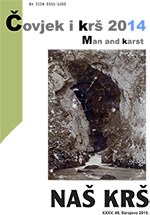HUMAN IMPACT ON POLJES - AN EXAMPLE OF SLOVENIA
HUMAN IMPACT ON POLJES - AN EXAMPLE OF SLOVENIA
Author(s): Andrej KranjcSubject(s): History, Geography, Regional studies, Human Geography, Historical Geography, Environmental Geography
Published by: Centar za krš i speleologiju
Keywords: poljes;human impact;karst;
Summary/Abstract: Poljes are a sort of oasis in karst: flat surface covered by soil and fed by springs attracted farmers since antiquity. But successful cultivation was often prevented by floods. First examples of improvement are known from the antiquity already, the Lake Copais (Greece) for instance. In Slovenia there are 10 poljes and 5 closed depressions, not unanimously considered as poljes. In the first printed reports poljes are praised as wonders of nature due to their seasonal appearance. In the 18th century researchers believed that poljes must be better exploited and first proposals of improvement appeared. The majority of interest was given to poljes of Notranjsko (Inner Carniola). More plans existed, yet not accepted and finally W. Putick was engaged by the Vienna’s Ministry to prepare the plan “for undamaged drain of poljes of Notranjsko” towards the end of the 19th century. Even his project was not fully accepted. Nevertheless more improvement works were executed, some realized by local communities. For Dolenjsko (Lower Carniola) the country’s engineer V. Hrasky prepared the plans and they were largely realized. After the 2nd WW more plans to meliorate poljes of Notranjsko were prepared, presuming two extremes: from complete drying up to permanent lake. None was completely realized. Recently, the attempts to renaturalize the polje of Cerknica are going on. In Slovenia, none of 10 poljes remains intact, as people always try to change the natural state or natural functioning.
Journal: Naš krš
- Issue Year: XXXV/2015
- Issue No: 48
- Page Range: 5-18
- Page Count: 14
- Language: English

